Топик: The History of Alaska (история Аляски)
Municipal Educational Institution
Lyceum № 130 “RAVES”
Exam paper.
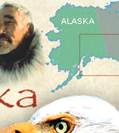
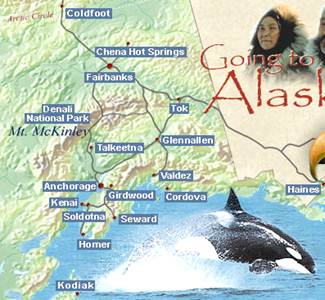
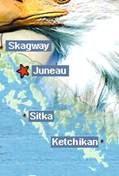
The History of Alaska.
Student: Protopopova N.S., M-111
Teacher: Shipulina O.N.
Barnaul, 2005
Contents:
Introduction……………………………………………………………………………………………………….……3
1. Origins of Alaska’s Groups……………………………………………………………………..…………4
The Eskimos
The Aathabascans
Aleuts
The Northwest Coast Indians
2. From the Russian Empire to the USA……………………………………………………………7
3. Alaska today………………………………………………………………………………………………………..8
Geography
Government
Business
Transport
4. The most important dates in the history of Alaska……………………….…………11
Conclusion………………………………………………………………………………………………………………..17
The list of literature………………………………………………………………………………………….…18
Introduction.
Undoubtedly, the history is one of the most interesting and most important sciences. It incorporates experience of each person and all mankind. The history acquaints us with process of development of a mankind. Behind acts and decisions of separate people, behind actions of weights there is a bright, many-sided and unique image of the world, different continents, the countries and people. To understand history of the Native land, it is necessary to understand world history. In the exam paper I will tell about history of Alaska – history, which connects two great powers - Russia and the USA. The purpose of the given work is to study political and social life of Alaska, its daily life, material, spiritual and religious culture. I will tell about the reasons and consequences of historical events of Alaska, I will cite statistical data. To be prepared of this exam paper I used the educational and scientific literature and materials of periodic printed editions.
1. Origins of Alaska’s Native Groups.

No
one knows exactly when people first found the land that would be called Alaska. Some anthropologists believe that people migrated from Asia to North America 40,000
years ago. Others argue it was as recent as 15,000 years ago.
Whenever, the consensus is that they came from Asia by way of a northern land
bridge that once connected Siberia and Alaska.
That land bridge, now recalled as Beringia, was the first gateway to Alaska. But these first visitors were hardly tourists intent on exploring new worlds.
Rather they were simply pursuing their subsistence way of life as they followed
great herds of grazing mammals across the grassy tundra and gentle steppes of
Beringia.
Some groups settled in the Arctic. Others traversed the mountain passes to
other parts of Alaska. While still others migrated through Alaska, continuing
on to distant lands--perhaps as far as South America.
Those who made Alaska their permanent home make up the state’s four major
anthropological groups: Eskimos, Aleuts, Athabascans, and Northwest Coast
Indians.
While all four groups shared certain basic similarities--all hunted, fished and
gathered food--they developed distinctive cultures and sets of skills.
The Eskimos:
Flexible
Residents of the Arctic.
The
Eskimos were primarily a coastal people, setting along the shores of the Arctic and Bering seas.
For millennia they lived a simple, subsistence life--much as they still do
today--by harvesting the fish and mammals of the seas, the fruits and game of
the land. Somehow they learned how to thrive despite the demanding conditions
of the Arctic.
Their sense of direction was keen, almost uncanny. Travelling in a straight
line, sometimes through snowstorms and whiteouts, they found their way around
the mostly featureless terrain by noting wind direction, the position of the
stars, the shape and size of a snowdrift. And they were resourceful. In a land
where the summer sun stays at eye-level for weeks on end, never setting below
the horizon, the Eskimos fashioned the first sun-visor--which also doubled as a
snow mask to protect their eyes from the wind-driven snow.
The Athabascans:
Nomads
of the Interior.
Like the Eskimos, the Athabascans were skilful hunters, but they depended more
on large land mammals for their subsistence--tracking moose and migrating
caribou.
When it came to fishing, the Athabascans were absolutely ingenious, snaring
fish with hooks, lures, traps and nets that are the fascination of modern day
anglers who visit their camps.
Generally nomadic, they lived in small, simply organized bands of a few
families, and whenever possible pitched their camps in the sheltered white
spruce forests of the Interior. Some adventurous tribes, however, wandered all
the way to the Southwest United States to become kin to the Navajos and
Apaches.
Aleuts:
Born
of the Sea.
For the Aleuts, life centred on the sea as they distributed themselves among
the 70-some islands in the Aleutian chain across the North Pacific.
Life here was somewhat more benign that in the Arctic, though wind storms were
sometimes strong enough to blow rocks around.
Since their food supply was rich, varied and readily available, the Aleuts had
time to develop a complex culture. Evidence indicates that they practiced
surgery and that their elaborate burial rituals included embalming. Instruments
utensils, even their boats were made with amazing beauty and exact symmetry. And
everything was fashioned for a specific purpose--the Aleuts used 30 different
kinds of harpoon heads for different species of game!
Skilled navigators and sailors, the Aleuts had the dubious distinction of being
the first to encounter the white man...Russian fur traders who took them as
slaves to harvest the fur seals in the Pribilofs.
The Northwest Coast Indians:
High
Society of Alaska’s southeast.
The milder, more temperate climate and an unlimited supply of salmon and other
seafood’s enabled the Northwest Coast Indians to evolve a way of life quite
different from the Eskimos, Aleuts and Athabascans. They settled in year-round
permanent villages, took slaves and lived their lives according to the strict
rules, rituals, and regulations of their respective clans. Their artwork was
nothing less than masterful...beautiful blankets, finely woven cedar bark and spruce
root baskets magnificent totem creations. Natives, who make up 15
percent of the state's population, maintain many traditions, such as whaling,
subsistence hunting and fishing, and old ways of making crafts and art. Native
heritage history and culture can be found in such diverse places as Ketchikan, Anchorage and Kotzebue, as well as in hundreds of villages where people live
in traditional ways.
But while Native culture, as a whole, may define much of Alaska's appearance,
the state contains a broad mixture of cultures. In Anchorage, for example, the
school district has found that its student body comes from homes that speak 83
languages. Anchorage, the state's biggest city, has many Alaska influences but
is also sometimes called Los Anchorage for its Lower 48-style architecture and
mannerisms. Most residents of Alaska were born outside the state, and when they
came to Alaska they brought their own traditions and desires.
There are European influences as well. Petersburg, in the Inside Passage, has a
strong Scandinavian heritage. Cordova and Valdez bear names bestowed by a
Spanish explorer; Cook Inlet is named for a British explorer; Russians left a
legacy of the Orthodox Church in much of the state.

2. From the Russian Empire to the United States of America.
The first written accounts indicate that the first Europeans to reach Alaska came from Russia. Vitus Bering sailed east and saw Mt. St. Elias. The Russian-American Company hunted otters for their fur. The colony was never very profitable, because of the costs of transportation.
At
the instigation of U.S. Secretary of State William Seward, the United States
Senate approved the purchase of Alaska from Russia for $7,200,000 on 9 April
1867, and the United States flag was raised on 18 October of that same year
(now called Alaska Day). The first American governor of Alaska was Włodzimierz
Krzyżanowski. The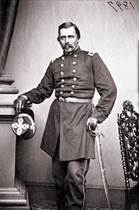 purchase was
not popular in the continental United States, where Alaska became known as
"Seward's Folly" or "Seward's Icebox". Alaska celebrates
the purchase each year on the last Monday of March, calling it Seward's Day.
purchase was
not popular in the continental United States, where Alaska became known as
"Seward's Folly" or "Seward's Icebox". Alaska celebrates
the purchase each year on the last Monday of March, calling it Seward's Day.
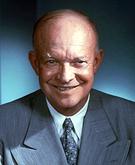 President Dwight
D. Eisenhower signed the Alaska Statehood Act into United States law on 7 July 1958 which paved the way for Alaska's admission into the Union.
President Dwight
D. Eisenhower signed the Alaska Statehood Act into United States law on 7 July 1958 which paved the way for Alaska's admission into the Union.
The name "Alaska" is most likely derived from the Aleut word for "great country" or "mainland." The natives called it "Alyeska", meaning "the great land." It is bordered by the Yukon Territory and British Columbia, Canada to the east, the Gulf of Alaska and the Pacific Ocean to the south, the Bering Sea, Bering Strait, and Chukchi Sea to the west, and the Beaufort Sea and the Arctic Ocean to the north.
In 1976, the people of Alaska amended the state's constitution, establishing the Alaska Permanent Fund. The fund invests a portion of the state's mineral revenue, including revenue from the Trans-Alaskan Pipeline System, 'to benefit all generations of Alaskans.' In June 2003, the fund's value was over $24 billion.
Over the years various vessels have been named USS Alaska, in honor of the state.
During World War II outlying parts of Alaska were occupied by Japanese troops. It was the only part of the United States to have land occupied during the war.
3. Alaska today.
Geography.
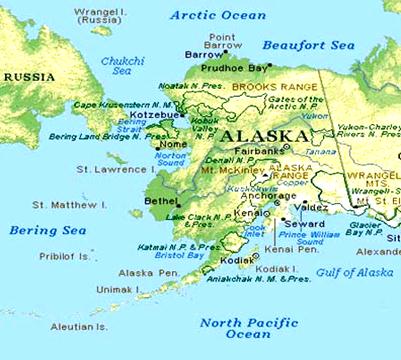 Alaska is the only state that is both in North America and not part of the 48 contiguous
states. Alaska is the largest state in the United States in terms of land area,
570,374 square miles (1,477,261 km²). If you superimposed a map of Alaska on the Lower 48 states, Alaska would stretch from Minnesota to Texas and from Georgia to California.
Alaska is the only state that is both in North America and not part of the 48 contiguous
states. Alaska is the largest state in the United States in terms of land area,
570,374 square miles (1,477,261 km²). If you superimposed a map of Alaska on the Lower 48 states, Alaska would stretch from Minnesota to Texas and from Georgia to California.
One scheme for describing the state's geography is by labeling the regions:
• South Central Alaska is the southern coastal region with towns, cities, and petroleum industrial plants;
• The Alaska Panhandle, also known as Southeast Alaska, is home to towns, tidewater glaciers and extensive forests;
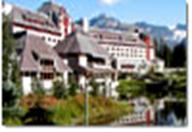 • the
Alaska Interior has big rivers, such as the Yukon River and the Kuskokwim
River, as well as Arctic tundra lands and shorelines; and
• the
Alaska Interior has big rivers, such as the Yukon River and the Kuskokwim
River, as well as Arctic tundra lands and shorelines; and
• The Alaskan Bush is the remote, uncrowned part of the state.
Alaska, with its numerous islands, has nearly 34,000 miles (54,700 km) of tidal shoreline. The island chain extending west from the southern tip of Alaska is called the Aleutian Islands. Many active volcanoes are found in the Aleutians.
Alaska is the easternmost state in the Union. The Aleutian Islands actually cross longitude 180°.
Alaska's most populous city is Anchorage, home of 260,284 people, 225,744 of whom live in the urbanized area. It ranks a distant third in the List of U.S. cities by area. Sitka ranks as the America's largest city by area, followed closely by Junea.
Government.
Much of Alaska is managed by the federal government as national forests, national parks, and national wildlife refuges. There are places in Alaska that are general public lands (BLM land) but they are arguably more spectacular than many national parks in the Lower 48. Many of Alaska's state parks would be national parks if they were in other states.
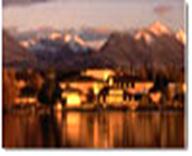
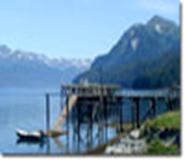 Much
of Alaska is managed by corporations called ANCSA, or native, corporations, of
which there are thirteen regional ones and dozens of local ones.
Much
of Alaska is managed by corporations called ANCSA, or native, corporations, of
which there are thirteen regional ones and dozens of local ones.
Alaska has no counties in the sense used in the rest of the country; however, the state is divided into 27 census areas and boroughs. The difference between boroughs and census areas is that boroughs have an organized area-wide government, while census areas are artificial divisions defined by the United States Census Bureau.
Business.
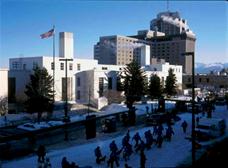 Alaska's main
agriculture output is seafood, although nursery stock, dairy products,
vegetables, and livestock are produced and used internally. Manufacturing is
limited, with most foodstuffs and general goods imported from elsewhere.
Employment is primarily in government and industries such as natural resource
extraction, shipping, and transportation. There is also a small but growing
service and tourism sector. Its industrial outputs are crude petroleum, natural
gas, coal, gold, precious metals, zinc and other mining, seafood processing,
timber and wood products.
Alaska's main
agriculture output is seafood, although nursery stock, dairy products,
vegetables, and livestock are produced and used internally. Manufacturing is
limited, with most foodstuffs and general goods imported from elsewhere.
Employment is primarily in government and industries such as natural resource
extraction, shipping, and transportation. There is also a small but growing
service and tourism sector. Its industrial outputs are crude petroleum, natural
gas, coal, gold, precious metals, zinc and other mining, seafood processing,
timber and wood products.
Transport.
Alaska has various transportation options. Some of Alaska is connected by roads (and sometimes a tunnel) to the highways of Canada and of the rest of the United States. These places are "on the road system". Along the Pacific Ocean, many places have freight and passenger service from ocean-going ships. Most places have air service, ranging from jets on tarmac to floatplanes on lakes.
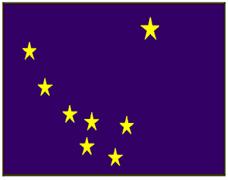
4. The most important dates in the history of Alaska.
August 21
- In 1732, a Russian expedition under
surveyor Mikhail Gvozdev sights
the Alaska mainland at Cape Prince
of Wales.
July 16
- In 1741, Vitus Bering, on St. Elias Day, sights the Alaskan
mainland. In honour of the saint, the most
prominent peak was named; this was the first point
on the northwest coast named by Europeans.
December 8
- In 1741, Vitus Bering died after his ship was wrecked on an
island off the Alaskan coast.
September 25
- In 1745, a Russian fur hunter, Mikhail Nevodchikov, reaches
Attu in his search for sea otters.
May 12
- In 1778, Captain James Cook entered Prince William Sound.
May 26
- In 1778, Captain James Cook entered Cook Inlet.
August 25
- In 1778, Captain James Cook turned back south
July
- In 1786, while charting Lituya Bay, 2 small boats are
swamped by rip tides, and 21 French sailors drown.
July 8
- In 1799, the Russian American Company is formed by Royal
Charter; they were given a 20-year monopoly on
trading on the coast from 55 degrees north.
March
- In 1812, the Russian American Company establishes a post at
Fort Ross, California to grow crops for their Alaska.
September
- In 1848, the Hudson's Bay Company builds Fort Selkirk, at
the confluence of the Pelly and Yukon Rivers.
- In 1852, Fort Selkirk is destroyed by a group of Tlingits who
objected to the Hudson's Bay Company trying to
break the Tlingit monopoly on trade with the
interior tribes.
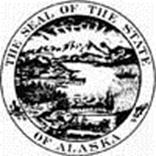 March 30
March 30
- In 1867, the United States purchased Alaska for
$7,200,000
July 23
- In 1867, Alaska's first post office is authorized, to
be opened at Sitka.
October 18
- In 1867, official ceremonies at Sitka transferred
Alaska from Russia to the United States.
July 27
- In 1868, the Customs Act is amended to include Alaska.
October 7
- In 1869, the prediction of a total solar eclipse by American
scientist George Davidson so impressed Kohklux,
chief of the Chilkat Indian village of Klukwan, he
drew him an incredibly detailed map of a vast part
of the interior of the Yukon and Alaska.
- In 1871, of the 41 whaling ships hunting in the Bering Sea,
32 are trapped by early ice; all of the 1,200 people
on the ships escaped, but 31 of the ships were
destroyed the following spring.
August
- In 1876, twelve whaling ships are trapped by ice near Point
Barrow; 50 men die attempting to reach safety.
July 2
- In 1882, George Krause becomes the first white man
allowed to cross the Chilkat Pass to the interior.
- In 1894, a resolution of the Privy Council authorizes the
North-West Mounted Police into the Yukon "in
the interests of peace and good government, in
the interests also of the public revenue." By June
26, Inspector Charles Constantine and Staff-
Sergeant Charles Brown were at Juneau, heading
for the goldfields of the British Yukon.
October 2
- In 1895, the North-west Territories was divided into the
Districts of Franklin, Mackenzie, Ungava and
Yukon.
August 17
- In 1896, a party consisting of George Carmack, his wife
Kate, Skookum Jim, Tagish Charlie and Patsy
Henderson stake placer gold claims on Rabbit
Creek, and rename the creek Bonanza Creek.
July 14
- In 1897, the Excelsior reaches San Francisco with the first
large shipment of Klondike gold.
July 17
- In 1897, the Portland reached Seattle with a large shipment
of Klondike, turning the excitement caused by the
Excelsior's arrival at San Francisco into an all-out
gold rush.
- In 1898, gold was discovered near the future site of Nome,
triggering a stampede.
- In 1898, a series of 5 avalanches in the Chilkoot Pass between
2:00 AM and noon killed over 70 people.
June 13
- In 1898, the Yukon Territory is created.
July 29
- In 1900, the White Pass & Yukon Route railroad was
completed, with the Golden Spike driven at
Carcross, Yukon.
- In 1900, Congress authorized a massive telegraph construction
project in Alaska.
July 22
- In 1902, Felice Pedroni ("Felix Pedro") discovered gold in
the Tanana Hills, causing a stampede which
resulted in the founding of Fairbanks.
May
- In 1904, the first commercial wireless communication
facility in the U.S. opened, between Nome and St.
Michael.
May 7
- In 1906, the Alaska Delegate Act was passed by Congress,
giving the territory's 40,000 people the right to elect
a non-voting delegate to Congress.
August 24
- In 1912, the Alaska Territorial Act was passed by Congress.
July 3
- In 1913, the first airplane in Alaska made a demonstration
flight at Fairbanks, piloted by James V. Lilly.
March 12
- In 1914, a bill authorizing the construction of the
government-financed Alaska Railroad was signed by
President Wilson. Construction started in 1915, and
some sections were opened as they were completed,
but the entire line, running from Seward to Fairbanks,
was not completed until July 15, 1923.
October 25
- In 1918, the coastal steamer Princess Sophia sunk near
Juneau, killing 463 people, about 10% of the
Yukon's white population.
- In 1919, the Yukon finally allowed women to vote in Territorial
elections. Manitoba had been the first province to
enfranchise women.
July 10
- In 1919, Louis Beauvette staked the first silver claim at Keno
Hill, in the central Yukon; by 1930 this district was
producing 14% of all the silver mined in Canada.
enfranchisement was passed in May 1918.
July 15
- In 1923, the Alaska Railroad was completed, following 8 years
of construction.
February 24
- In 1924, Carl Ben Eielson made Alaska's first Air Mail flight.
June 3
- In 1942, a large carrier-based Japanese force attacked
Dutch Harbour.
June 7
- In 1942, the Japanese landed almost 2,500 troops on the
Aleutian islands of Attu and Kiska. It took a huge
Allied force until August 15, 1943 to regain control.
September 24
- In 1942, the Alaska Highway opened at Contact Creek, 305
miles north of Fort Nelson, B.C.
February 22
- In 1951, after 3 years of rumours, the federal government
approved moving the capital of the Yukon from
Dawson City to Whitehorse. A new Federal Building
was constructed in 1952, and the Territorial
Council chambers were moved the following year,
with the first meeting held in Whitehorse in April.
- In 1951, the Alaska Highway was turned over to Canada, in a
ceremony at Whitehorse.
January 3
- In 1959, Alaska became the 49th State.
March 27
- In 1964, an earthquake with a magnitude of 8.4 on the
Richter scale hits the Anchorage area, killing 115
people and destroying hundreds of homes.
November 6
- In 1967, Jean Gordon, the Yukon's first female member of
the Territorial Council, takes her seat.
- In 1968, the oil riches of Alaska's North Slope, first
reported almost 100 years ago, were confirmed by
a drilling program at Prudhoe Bay. The following
year, a total of $990,220,590 was bid in a one-day
lease sale of those properties.
January 23
- In 1971, the temperature at Prospect Creek, Alaska,
dropped to 80 degrees below zero, the lowest
temperature ever recorded in the United States.
December 18
- In 1971, the Alaska Native Claim Settlement Act (ANCSA)
was signed into law by the President. Among the
major provisions were the transfer of title to 40
million acres of land to native corporations, and a
cash payment of $962.5 million.
February 14
- In 1973, the Yukon Native Brotherhood presented a
Statement of Claim to the federal government,
stating their position on land claims, self-
government and other issues which had been
published in January in "Together Today For Our
Children Tomorrow".
- In 1975, the first section of pipe for the Trans-Alaska
Pipeline from Prudhoe Bay to Valdez was laid. By
August, 21,600 people were working on the project.
The first oil was put through the 800-mile line on
June 20, 1977.
February 3
- In 1988, PL 100-241, the Alaska Native Claim Settlement
Act Amendments, was signed by President Regan.
The amendments gave more flexibility to the
corporations managing Settlement lands.
March 24
- In 1989, the oil tanker Exxon Valdez went aground on Bligh
Reef, pouring almost 11 million gallons of oil into
Prince William Sound.
May 29
- In 1993, the Umbrella Final Agreement is signed by
representatives of the Council for Yukon Indians
and the Yukon and federal governments,
establishing the basic format for all 14 Yukon First
Nations land claims agreements.
Conclusion.
Summing up to the aforesaid, it would be desirable to emphasize, that Alaska is a crossroads of a sea, air truck transport between Northern America, Asia and the Europe, that’s why Alaska is one of the most perspective states of USA by way of development of economy and tourism. The variety of riches of culture, an abundance of national parks attracts tourists from the world.
The considerable contribution to development of Alaska was brought by Russian empire. The general past, the general cultural wealth is what unites Russia and Alaska and today.
The list of literature.
1. Джеймс Микэнер «Аляска».
2. Боб Черрай «Дух Ворона».
3. Marcia Simpson «Rogue's Yarn», «Crow in Stolen Colors»,
«Sound Tracks».
4. Gore Vidal «Williwaw».
5. Borneman «The Native People of Alaska»
6. http://www.encyclopedia.thefreedictionary.com
7. http://www.alaskacam.com
8. http://www.alaska.com
9. http://www.goingtoalaska.com
10. http://www.mapquest.com